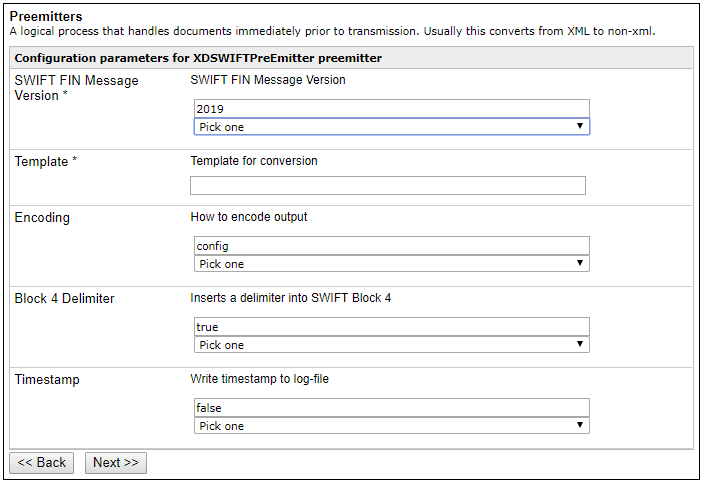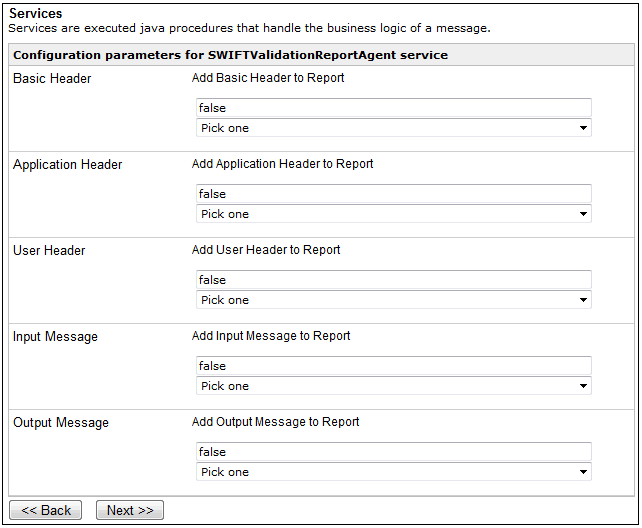Components of the iWay Integration Solution for SWIFT
|
Topics: |
iWay business components used in the construction of a message flow for SWIFT messages include:
- An Ebix (e-Business Information Exchange)
- A preparser
- A validation report
- A preemitter
Ebix
iWay Software provides various e-Business Information Exchange (Ebix) files used in conjunction with the iWay integration solutions. In iWay Service Manager, the iWay Integration Solution for SWIFT contains several Ebix files, one for each supported SWIFT FIN year.
Ebix files for SWIFT FIN are named SWIFT_ccyy.ebx, where ccyy is the release year. For example, the Ebix file for the 2019 SWIFT FIN message is named SWIFT_2019.ebx.
For details on the supported SWIFT FIN messages, see Ebix-Supported Transaction Sets.
An Ebix is a collection of metadata that defines the structure of data. The Ebix supplied with the iWay Integration Solution for SWIFT defines the structure of supported SWIFT messages.
Each Ebix includes:
- Pre-built
data dictionaries. The structure of each SWIFT document is described
by the dictionary, which describes the segments and elements that
compose each document.
The dictionaries from the Ebix are used to transform the structure of a document per SWIFT standards.
- Pre-built XML schemas that define the structure and content of XML messages in detail.
- Pre-built SWIFT to XML transformation templates, and XML to SWIFT templates, for the supported SWIFT FIN messages.
- Pre-built rule files for each SWIFT message. The iWay Integration Solution for SWIFT uses these rule files to validate inbound and outbound documents for network rule compliance and other data checking.
Preparsers
A preparser is an iWay business component that converts incoming messages into processable documents.
Typically a preparser converts a non-XML document into XML format. The preparser for the iWay Integration Solution for SWIFT converts an incoming SWIFT message to XML format.
There are four preparsers that are provided with the iWay Integration Solution for SWIFT:
- XDSWIFTPreParser (com.ibi.preparsers.XDSWIFTPreParser)
- Recommended preparser to use for inbound SWIFT processing.
- Processes a single SWIFT message through a SWIFT inbound channel.
- Transforms system messages to XML, and will create output as any other documents.
- Use in combination with XDSWIFTValidationReportAgent to produce a SWIFT validation report.
- Channel configuration requires an Ebix attachment.
The following preparsers can be used in specific situations:
- SWIFTACKPreparser (com.ibi.preparsers.SwiftBPP)
- Expected inbound SWIFT contains only SWIFT ACK (F21) messages.
- XDSWIFTBatchSplitter (com.ibi.preparsers.XDSWIFTBatchSplitter)
- Expected inbound SWIFT data contains multiple SWIFT messages.
- SWIFT inbound channel should include:
- SWIFTACKPreparser and the SWIFTPreparser.
- XDSWIFTPreParser, which processes SWIFT ACK messages and standard messages.
- SWIFTSystemMessagePreParser (com.ibi.preparsers.XDSWIFTSysMsgPreParser)
- Expected inbound SWIFT data contains only SWIFT system messages.
Note: SWIFT system messages do not require any Ebix. As a result, their transformation cannot be modified.
Preemitter
A preemitter is a logical process that handles a document immediately before transmission.
Typically a preemitter is used to convert an XML document to non-XML format. The XML document is created from SWIFT input data in inbound processing. The iWay Integration Solution for SWIFT uses a preemitter in outbound processing to convert the XML-formatted SWIFT document to a SWIFT formatted document.
The XML structure must be compliant with the schema supplied in the Ebix.
The preemitter that is provided for the iWay Integration Solution for SWIFT is the XDSWIFTPreEmitter (com.ibi.preemit.XDSwiftPreEmitter). An Ebix attachment is required for the iSM channel.
The following image shows the available configuration parameters for the SWIFT preemitter in the iSM Administration Console.

Validation Report Service
There is a validation report service that is provided with the iWay Integration Solution for SWIFT. The validation report is structured in XML format. It contains the input document, the output document, and indicates whether the message is compliant with the SWIFT defined standards.
- XDSWIFTValidationReportAgent (com.ibi.agents.XDSWIFTValidationReportAgent)
- Used for inbound and outbound SWIFT processing.
- Reports the results of structural validation from Transformer and Network Validation from Rules processing. Outputs an XML report file with the input document, the output document, and the results of validation.
- An Ebix attachment is required for the iSM channel to invoke validation.
The following image shows the available configuration parameters for the SWIFT validation report service in the iSM Administration Console.

iWay Service Manager Channel Configuration
This section provides sample use case iSM channel configurations.
|
Use Case |
Attach Ebix? |
iSM Components |
|---|---|---|
|
Inbound processing with SWIFT rules validation |
Yes |
Preparser: XDSWIFTPreParser (com.ibi.preparsers.XDSWIFTPreparser) Service: XDSWIFTValidationReportAgent (com.ibi.agensts.XDSWIFTValidationReportAgent) |
|
Outbound processing with SWIFT rules validation |
Yes |
Service: XDIWAYSWIFTXXMLTransformAgent (com.ibi.agents.XDIWAYSWIFTXMLTransformAgent) Service: SWIFTValidationReportAgent (com.ibi.agents.XDSWIFTValidationReportAgent) |
SWIFT Message Structure
|
Topics: |
In the SWIFT message structure, blocks 3, 4, and 5 may contain sub-blocks or fields delimited by field tags. Block 3 is optional. Many applications, however, populate this with a reference number so that when the Acknowledgement is returned by SWIFT, it can be used for reconciliation purposes.
Basic Header Block
The basic header block has the following format:
{1: F 01 BANKBEBB 2222 123456}
(a) (b) (c) (d) (e) (f)Note: Blank spaces have been added for readability purposes.
The basic header block has a fixed length and is continuous with no field separators:
a) Block ID - always '1:' b) Application ID - F = FIN, A = GPA or L = GPA (logins, etc) c) Service ID - 01 = FIN/GPA, 21 = ACK/NAK d) LT address - 12 Characters, must not have 'X' in position 9 e) Session number - added by the CBT (Computer Based Terminal), padded with zeroes f) Sequence number - added by the CBT (Computer Based Terminal), padded with zeroes
Application Header Block
The application header block has a different format depending on whether it is being sent to or from SWIFT.
The input structure (to SWIFT) is:
{2: I 100 BANKDEFFXXXX U 3 003}
(a) (b) (c) (d) (e) (f) (g)Note: Blank spaces have been added for readability purposes.
This structure has a fixed length and is continuous with no field separators from user to SWIFT.
a) Block ID - always '2:'
b) I = Input
c) Message Type
d) Receivers address with X in position 9 and padded with X's if no branch
e) Message Priority - S = System, N = Normal, U = Urgent
f) Delivery Monitoring - 1 = Non Delivery Warning (MT010)
2 = Delivery Notification (MT011)
3 = Both Valid = U1 or U3, N2 or just N
g) Obsolescence Period - when a non delivery notification is generated
Valid for U = 003 (15 minutes)
Valid for N = 020 (100 minutes)The output structure (from SWIFT) is:
{2: O 100 1200 970103BANKBEBBAXXX2222123456 970103 1201 N}
(a) (b) (c) (d) (e) (f) (g) (h)This structure has a fixed length and is continuous with no field separators from user to SWIFT.
a) Block ID - always '2:' b) O = Output c) Message Type d) Input time with respect to the Sender e) MIR with Senders address f) Output date with respect to Receiver g) Message priority
User Header Block
The user header block has the following structure:
{3: {113:xxxx} {108:abcdefgh12345678} }
(a) (b) ( c)Note: Blank spaces have been added for readability purposes.
This is an optional block and is similar in structure to system messages.
a) Block ID - always '3:' b) Optional banking priority code c) Message User Reference MUR used by applications for reconciliation with ACK
Other tags exist such as 119 which can contain the code ISITC on an MT521 or 523 providing the sender and receiver are registered to do so with SWIFT. This forces additional code word and formatting rules validation of the body of the message as laid down by ISITC (Industry Standardization for Institutional Trade Communication).
113. 4 characters (SWIFT x Character Type) Banking Priority: (HYnn) H- Highly Urgent, U- Urgent, N- Normal, Y- Request Receiving, N- Do Not Request Receiving, nn- May or may not be used.
108. 16 characters (SWIFT x Character Type) MUR (Message User Reference). 1234459898ABC used to reconcile with ACKs.
119. 8 uppercase characters or numbers. Bank User Defined.
Text Block or Body
This block is where the actual MTnnn message is specified and is what most users will see. Generally the other blocks are stripped off before presentation. The format is as follows:
{4:
:20:123456
:25:123-456789
:28C:102
:60F:C020527EUR3723495,
:61:020528D1,2FBNK494935/DEV//67914
:61:020528D30,2NCHK78911//123464
:61:020528D250,NCHK67822//123460
:61:020528D450,S103494933/DEV//P064118
FAVOUR K. DESMID
:61:020528D500,NCH45633//123456
:61:020528D1058,47S103494931//3841188
FAVOUR H. F. JASSEN
:61:020528D2500,NCHK56728//123457
:61:020528D3840,S103494935//3841189
FAVOUR H. F. JANSSEN
:61:020528D5000,S20023/200516//47829
ORDER ROTTERDAM
:62F:C020528EUR3709865,13
-}The example above is an MT950, Statement Of Cash. Fields specified are in accordance to the appropriate volume of the user handbook, there is one or more for each message category.
The format of field tags is:
:nna:
nn - numbers
a - optional letter which may be present on selected tags
eg - :20: Transaction Reference Number
:25: Account Identification
The length of a field is designated thus:
nn - maximum length
nn! - fixed length
nn-nn - minimum and maximum length
nn * nn - max number of lines times max
line lengthThe format of the data is designated thus:
n - Digits d - Digits with decimal comma h - Uppercase hexadecimal a - Uppercase letters c - Uppercase alphanumeric e - Space x - S.W.I.F.T. character set y - Upper case level A ISO 9735 characters z - S.W.I.F.T. extended character set
Some fields are defined as optional and if not required they must not be present as no blank fields must be present in the message.
/,word - Characters as-is […] - optional element
For example:
4!c[/30x] - fixed 4 uppercase alphanumeric, optionally followed by a slash
and up to 30 S.W.I.F.T. characters
ISIN1!e12!c - code word followed by a space and fixed 12 uppercase alphanumericsIn some message types certain fields will be defined as conditional, for example, if a certain field is present then another field may change from optional to mandatory or forbidden.
Certain fields have different formats dependant on the option which is chosen, which is designated by a letter after the tag number, for example:
:32A:000718GBP1000000,00 Value Date, ISO Currency and Amount :32B:GBP1000000,00 ISO Currency and Amount
It is important to note that the S.W.I.F.T. standards for Amount formats are, no thousand separators and a comma for a decimal separator.
:58A:NWBKGB2L Beneficiary S.W.I.F.T. address :58D:NatWest Bank Beneficiary full name and address Head Office London
115--> 32 characters (SWIFT x Character Type)SWIFT x Character Types= 0-9,a-z, A-Z, /-?:().,'+
Trailer Block
|
Topics: |
A message always ends in a trailer with the following format:
{5: {MAC:12345678}{CHK:123456789ABC}It contains a number of fields that are denoted by keywords such as:
- MAC: Message Authentication Code calculated based on the entire contents of the message using a key that has been exchanged with the destination and a secret algorithm. Found on message categories 1,2,4,5,7,8, Most 6's and the 304.
- CHK: Checksum calculated for all message types.
- PDE: Possible Duplicate Emission added if user thinks that they may have sent the message previously.
- PDM: Possible Duplicate Message added by S.W.I.F.T. if they think that a message may have been transmitted previously.
- DLM: Added by S.W.I.F.T. if an Urgent message has not been delivered within 15 minutes or a Normal message within 100 minutes.
Validation Report
The Validation Report service contains options that will allow the user to include or suppress the Basic, Application, and User Headers from the report.